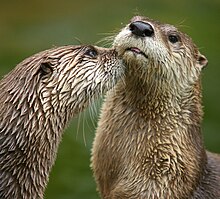By Megan Naylor
Editorial Communications intern, Spring/Fall 2010

North American River Otters are the jesters of the waterways.
Officially they belong to the Mustelidae family, sharing ancestry with badgers, minks and weasels.
It is not unusual to see them using grass, mud and snow banks leading to the river as their own personal playgrounds, slipping and sliding as they launch their bodies into the water below.
Moving agilely in the water is their strong suit since they are quick, nimble, playful and sleek.
Otters can swim backwards as well as forwards, do their own version of the back stroke (more like a back float kick), and tread water which is important because they must remain in motion to keep their position on the surface.
Their small eyes and ears, long slender bodies, thick tapered tails and compact round muzzles give them a stealthy distinguished look, which is fitting in their line of work since they need to move quietly and efficiently when fishing.
They can swim up to 6.8 miles per hour, dive up to 60 feet, and stay below for nearly 4 minutes.
Their eyes are protected by a translucent eyelid called a nictating membrane. The membrane is essentially a built-in pair of swimming goggles allowing them to see uninhibited while submerged.
The tail is used for stabilization and for short bursts of rapid propulsion, often used to chase food or escape predators.
Short legs,webbed feet and thick waterproof fur round out their swimming costume.
Having fully webbed toes allows them to glide smoothly and pick up speed quickly when chasing down a meal.
Otters tend to favor fish but also eat amphibians, turtles and crayfish.
The title river otter can be somewhat misleading, since they dwell in saltwater areas as well as freshwater. Habitat areas they frequent include: lakes, rivers, inland wetlands, coastal shorelines and marshes and estuaries.
Shelter typically consists of hollow logs or abandoned dens and burrows of other animals.
Though North American River Otters once played and swam freely along the banks of North America’s rivers their numbers have lowered due to heavy trapping, habitat destruction and pollutants.
Conservation and reintroduction have helped to repopulate areas in the U.S where numbers were low to non-existent, but river otter populations are still struggling to stay afloat.
They are still viewed as vulnerable throughout much of their range in mid western United States and the Appalachian mountains.
Many biologists believe that the best way to ensure the survival of the otter is to vote for clean water and support sustainable agriculture and development.



Leave a Reply